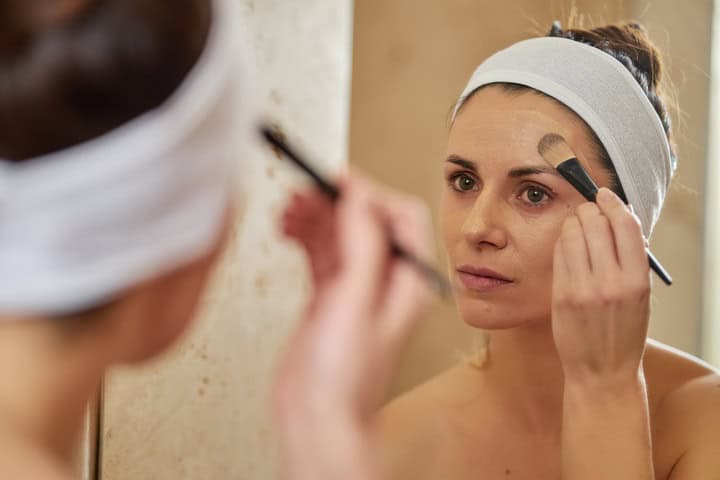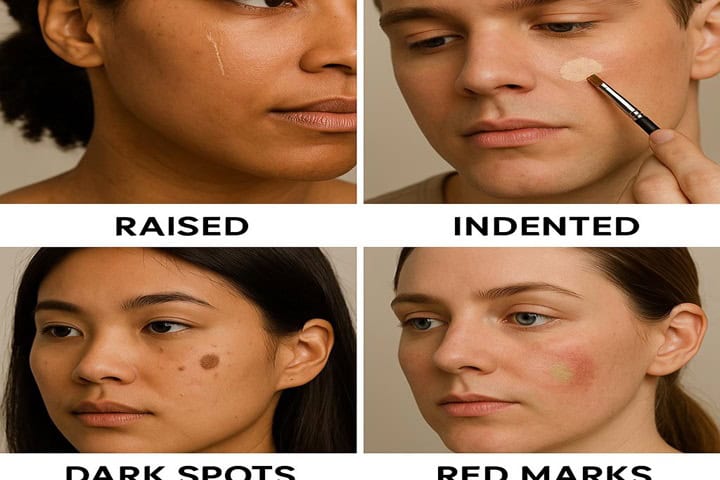How To Cover Scars With Makeup: Simple Tips & Tricks
5th July, 2025
Scars can knock your confidence—but makeup can help you feel more like yourself again. With the right steps, even deep or discoloured scars can be softened or hidden completely.
Whether you’re preparing for a performance or just want smoother-looking skin day to day, covering scars with makeup can make a big difference. This guide walks you through how to cover a scar with makeup, which products work best, and how to tweak your technique for different types of scars—from raised to red to indented.
Key Points:
- Different scar types need different coverage methods
- Start with moisturiser and primer for better results
- Apply foundation before concealer to avoid heavy buildup
- Use colour correctors to neutralise red or dark spots
- Set your makeup to keep coverage in place all day
How Covering Scars with Makeup Differs from Everyday Makeup
Standard makeup is designed to highlight features, even out skin tone, or create a dramatic effect—especially in performance settings. But if you’re trying to cover a scar with makeup, the goal is different. Scar coverage focuses on texture, colour correction, and durability.
Makeup for hiding scars uses thicker, more pigmented formulas that are made to stay in place and blend well into scarred or uneven skin. These products work harder than everyday concealer or foundation, especially when you’re dealing with textured, discoloured, or indented areas.
Regular makeup may not fully cover raised or shiny scars, while camouflage makeup is specifically developed for this purpose. It often includes skin-tone-correct pigments that help soften the look of scars without caking or drawing more attention.
Recommended Brands for Scar Camouflage
If you’re wondering how to cover scars with makeup and want reliable results, start with brands trusted by professionals and dermatologists alike:
- Bdellium Tools – Known for long-wear, high-coverage foundations and concealers that blend seamlessly with most skin types.
- Delilah Cosmetics – Offers flexible shade ranges and customisable coverage, great for different undertones and scar types.
- Kryolan Makeup – A go-to in stage makeup circles, Kryolan’s camouflage creams are hard-wearing and ideal for dramatic cover.
Techniques for Better Scar Coverage
Covering scars with makeup takes a few careful steps to get it right. Always start with clean, moisturised skin. Hydration helps your base stick better and go on smoother.
- Apply a primer to smooth out texture, especially if the scar is raised or indented.
- Use a brush or sponge to press product into the scar, not just swipe over it.
- Build coverage slowly using foundation first, then concealer.
- Set with powder, and finish with setting spray for longer wear.
The Emotional Benefit
Knowing how to cover scars with makeup isn’t just about appearance—it can be about feeling comfortable in your skin again. Whether the scar is from surgery, acne, or injury, having tools that help hide it can give you a sense of control and confidence.
Browse our range of cheek makeup and make your cheekbones shine more, both on and off stage
How to Cover Scars with Makeup: A Step-by-Step Guide

If you’re learning how to cover scars with makeup, getting the base steps right is just as important as choosing the right product. The skin around scars often behaves differently—it can be drier, smoother, or more textured.
Below is a simple step-by-step guide to help you create a smoother, more even look using makeup for hiding scars.
1. Moisturise First
Of course, always start by making sure your skin is clean and moisturised. This helps makeup sit better and prevents dry, flaky patches from standing out. Hydrated skin creates a smoother base and helps products blend in more easily, especially around textured areas or older scars.
Use a lightweight moisturiser that suits your skin type—gel for oily skin, cream for dry. Let it absorb fully before moving on.
2. Apply a Primer
A primer helps fill in uneven areas and smooths the skin surface. It also helps your makeup last longer and cling better to tricky areas. If your scar is indented or has texture, choose a silicone-based primer to lightly fill it in and make the surface more even.
For those covering flat scars or discolouration, a hydrating or brightening primer may be more useful. Always apply with clean fingers or a sponge, focusing on the scarred area.
Learn more about why it is important to understand the distinction between applying primer or moisturiser first
3. Use Foundation Before Concealer
It might be tempting to go straight in with concealer, but applying foundation first can help reduce how much product you need. Use a thin, even layer of foundation to balance your skin tone. Choose a long-wear or full-coverage formula for better staying power.
Apply the foundation with a sponge or brush and gently press it into the skin—especially around the scar—to avoid streaks. After the first layer, step back and assess whether you still need extra coverage.
4. Apply Concealer for Extra Coverage
Once your foundation is in place, move on to concealer. This is where you target the scar directly. For dark spots or red marks, choose a high-coverage concealer that matches your skin tone. Tap it into place using your fingertip or a small brush.
If you’re covering a deeper scar, try a slightly lighter concealer at the centre to create a “lifted” effect. This can help reduce shadows and create the illusion of smoothness.
5. Set Your Makeup
To keep everything in place, use a setting powder or spray. Press a small amount of translucent setting powder over the scarred area to prevent the makeup from moving or settling into lines.
Finish with a setting spray to lock everything in for longer wear—especially helpful in heat or under stage lighting.
Adjusting Your Technique by Scar Type

When covering scars with makeup, no single technique works for all scar types. The way you apply products will depend on the texture and tone of your scar.
- For Raised Scars (Hypertrophic): Raised scars often reflect more light and appear shiny. Use mattifying formulas to reduce the shine and help product grip better. Stick with lightweight layers and blend carefully to avoid drawing attention to texture.
- For Indented or Pitted Scars: Indented scars, like those caused by acne, may benefit from a thick, filling primer. You can also use a light concealer directly in the deepest part of the scar to reduce shadow and make it look more level. A small eyeliner brush can help you apply the product precisely.
- For Dark Spots: Dark scars from hyperpigmentation respond best to highly pigmented concealers. Use a long-wear option and consider applying a light layer of powder before and after to help the product stick and stay put.
- For Red Marks: Red scars can often be neutralised with a green colour corrector. Dab a small amount over the redness before layering your foundation and concealer. This technique helps reduce the appearance of red tones and can prevent your makeup from looking too pink or uneven.
Benefits and Limitations of Covering Scars with Makeup

Scar camouflage makeup can do more than just hide marks—it can help people feel more confident in their skin. Still, while there are many benefits to using makeup for hiding scars, there are also times when it’s better to avoid it.
Confidence Boost
Learning how to cover scars with makeup can be life-changing for some. Whether the scar is from surgery, acne, or injury, many people feel self-conscious and want a way to feel more comfortable in public or on stage. By covering scars with makeup, individuals often feel more at ease in social situations or during performances.
For some, being able to cover a scar with makeup means they’re more likely to go out, attend events, or meet new people without constantly thinking about how their skin looks. The right coverage can offer peace of mind and help people focus on enjoying their day, rather than worrying about their appearance.
Limitations of Scar Makeup
Despite its benefits, scar makeup isn’t for everyone. Some products can irritate sensitive skin or cause breakouts, especially if they contain strong pigments or long-wear formulas. Always do a patch test first to make sure your skin won’t react badly.
Durability
Another point to consider is durability. Not all scar makeup is waterproof or sweat-proof. In warm weather or after physical activity, the coverage may fade or transfer. This means you might need to touch up throughout the day, which can be inconvenient if you’re busy or on the go.
Learn more about protecting your skin and makeup in hot weather with:
Targeted and Full Coverage Options
Makeup for hiding scars can be used in two main ways:
- Targeted coverage – Ideal if you want to cover a single scar or small area. Use a brush or sponge to apply products directly where needed.
- All-over coverage – Best for those with several scars or uneven skin tone. Some products are designed to be used across the whole face or body for a smooth finish.
Both methods allow flexibility depending on your needs and comfort level.
When Not to Use Scar Makeup
There are, of course, some instances when you should not use scar makeup, including the following:
- Open Wounds: Never apply makeup to an open wound. Doing so can trap bacteria, cause infections, and slow the healing process. Always wait until the skin has fully healed before applying any cosmetics.
- Allergic Reactions: Some people react to ingredients in camouflage makeup. Redness, itching, or swelling can occur. Test the product on a small area and wait 24 hours before using it on larger areas.
- After Skin Treatments: If you’ve recently had a skin treatment like a chemical peel or laser therapy, avoid makeup until your skin has fully recovered. The skin may be more sensitive, and makeup could interfere with healing.
- Skin Conditions: If you have skin conditions like eczema, rosacea, or psoriasis, using heavy scar makeup may cause flare-ups. In these cases, lighter coverage or dermatologist-approved products may be better.
For temporary to permanent facial scars, check out these pivotal treatment options for scars.
The Best Makeup Products to Cover Scars
When choosing makeup for hiding scars, product quality matters. At Treasure House of Makeup, you’ll find a wide range of high-performance, professional-grade products designed to help you cover a scar with makeup easily—whether for the stage, camera, or everyday life.
From full-coverage bases to colour correctors and setting sprays, here are some top product types to consider when covering scars with makeup.
Full-Coverage Foundation
A high-coverage foundation is a key part of learning how to cover scars with makeup. Brands like Kryolan offer theatre-quality bases such as Kryolan Dermacolor Camouflage Creme, known for its intense pigment and long-lasting wear. It’s ideal for hiding discolouration, surgical scars, or acne scarring on the face and body.
Colour Correctors
Before applying foundation, neutralise any redness or dark tones with a colour corrector. For example, we stock the Kryolan Supracolor palette, which include green (to counter redness) and peach/orange tones (to balance blue or purple scars). These are easy to blend and perfect for layering under cream foundations.
Primers and Fillers
To smooth out textured or indented scars, use a silicone-based primer like Mehron’s Velvet Finish Primer Serum. This helps to blur uneven skin and allows for better foundation grip. It’s lightweight but effective—great for use under heavier scar coverage makeup.
Setting Powders and Sprays
To lock your makeup in place, try Ben Nye Luxury Powder, both available from our site. These are trusted by makeup artists for keeping coverage intact under hot lights or long wear.
FAQs
How do I cover red or inflamed scars with makeup?
- Apply a green colour corrector to neutralise redness
- Blend lightly and follow with full-coverage concealer or foundation
- Use a setting powder to prevent movement
Can men use makeup to cover scars?
Will makeup make my scars worse over time?
Sources
De Pietro, M.A., (2023) What You Should Know About Hyperpigmentation. Healthline. [online] Available at: https://www.healthline.com/health/hyperpigmentation [accessed 16/06/2025]
Cherney, K., (2017) Treatment Options for Facial Scars. Healthline. [online] Available at: https://www.healthline.com/health/beauty-skin-care-scars-spots [accessed 16/06/2025]
Hey there! I’m Isabelle Kerrington, and I’m thrilled to share my passion for the performing arts through my blog. Focusing on theatre makeup, my posts will cover everything from product recommendations to helpful tips and engaging tutorials. Join me on this exciting journey as we explore the magical world of theatre makeup together.
Leave a Reply